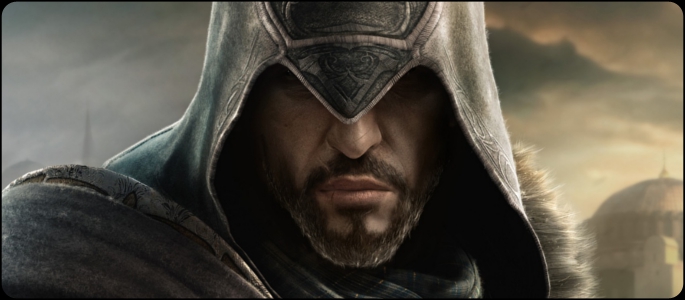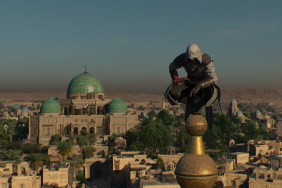The Assassin’s Creed series has steadily improved with each console iteration; gameplay mechanics have been streamlined and new features, like multiplayer, have been added. But with Assassin’s Creed Revelations set to be the third game centered around Ezio Auditore da Firenze, the original lure of a time-hopping adventure where every game is set in a different era hasn’t been fully realized. With that in mind, does Revelations bring anything new to the table, or is it one Ezio game too many?
To find out, PlayStation LifeStyle headed to London for an in-depth playthrough of several key sequences from Assassin’s Creed Revelations‘ single-player campaign, and to sit down with the lead writer behind the game (editor’s note: we played the 360 version). It’s hard to become bored of the loveable Italian bachelor Ezio, but while he may still be single, he is no longer the same man – age has taken its toll on the master assassin, his face is puffier, wrinklier and is partially covered by a grey beard. Luckily for us, the years have been a lot kinder to the rest of his body as he is still able to nimbly clamber up buildings and jump across rooftops without breaking a sweat.
In the first sequence we played, Ezio arrived in Constantinople (now Istanbul) battered and worn out from his time in Masyaf and it was immediately clear that the city was unlike any Ezio had gone to before. A far cry from the carefully crafted renaissance cities of Italy, Constantinople is dustier, dirtier and more alive. Split asunder by the mighty Bosphorus – a Turkish Strait rather than a mere river – the city is positioned right on the edge of two vastly different cultures: on one side of the Bosphorus, Constantinople is in Europe, and on the other side of the sea it is in Asia. This allows for a greater mix of weapons, clothes and architecture, with the developers able to draw on inspiration from either continent. Sections of Constantinople are vibrant with color, especially when there are a few brightly garbed Turkish citizens, while other sections are filled with more chromatically subdued, sun-hardened mud structures.
But the environment isn’t the only feature that has changed due to exotic influences, as Ezio soon meets the city’s native assassins, and they introduce him to the hookblade. Fellow assassin Yusuf Tazim first shows Ezio the new gameplay mechanic, an alteration to the standard hidden blade, and demonstrates it in a quick tutorial set in a small section of the sprawling metropolis. Essentially, the hookblade acts as an extension of Ezio’s arm, as a hook shoots out to grab onto hard to reach places, giving you the ability to climb faster and higher than ever before. It’s a nifty idea that does bring something new to the climbing system that has mostly been left unchanged, although it will require you to re-learn which jumps can and can’t be made. The hookblade also allows assassins to zipline across rooftops where there happen to be really long washing lines, and is a great way to travel at high-speed across the city. In addition, the hookblade can also be used as a non-lethal weapon, allowing Ezio to ‘hook’ onto an enemy while running, and then roll over their back, and keep on escaping – all without slowing down. It can also be used to trip people up when you are standing still and, while we didn’t see much use in doing so, it did give us a way to annoy innocent civilians without risking desynchronization.
Combat didn’t seem to be overhauled in any major way, but it was refined and tweaked as you’d expect. However, while the combat hasn’t changed much, the enemies have; Ottoman Janissaries are huge, tough and plentiful – far more prolific than the stronger soldiers in previous titles. Set quite a while after Brotherhood, guns have become even more commonplace, but the real difficulty lies in fighting multiple Janissary soldiers, all of whom have wrist guns too, and so can hem you in with blows from their heavy weapons and shoot you where you stand. The Assassin’s Creed team told me that the Janissary were implemented to give series fans more of a challenge, and they certainly have achieved that.
The franchise has evolved past simple Assassin’s Vs Templars, introducing more layers and depth to the ongoing war between the two magical artifact-obsessed factions. The Templars are in a more weakened state, much of their wealth and power destroyed by Ezio in the past two games, but they still won’t go down without a fight. A remnant of the Eastern Roman Empire, the Byzantines are desperate to reclaim their city from the Ottomans, and there is a constant turf war between the two groups throughout the game. In fact, if you fall foul of too many Byzantines, you can lead them to some Ottomans and the two parties will fight to the death. While the Byzantines are controlled by the Templars, the Ottomans are mainly harmless, and are not out to hurt you. In fact, if you run across the rooftops and come upon an Ottoman guard, they will say something like “Hope I’m that spry at his age” before you repeatedly stab him in the face.
A new addition that will let you get past guards without killing them (or alternatively allow you to blow them up) is the introduction of a whole host of new bombs. Instead of just being able to drop smoke bombs, you can now throw various bombs/antique grenades at soldiers to achieve different goals. We only were able to play with three types of bomb, but spotted a station where you could mix materials and ingredients to perfect your bomb – apparently, there are 300 variations of bomb. ‘Diversion’ bombs are flashbangs that distract guards and give you a chance to slip past them unseen without raising the alarm, ‘Caltrop’ bombs drop small caltrop spikes that slows down pursuers and ‘Splinter’ (our favorite) is the classic explode-and-kill grenade.
In one mission, Ezio must sneak his way into a party without being seen. To do so, he knocks out all the minstrels and takes their clothes. However, each group of minstrels is surrounded by numerous guards, and the only way to reach them is by using a clever combination of bombs. Then, along with a group of other, similarly dressed, assassins, Ezio infiltrates the party and uses his eagle vision to spot his enemies. The mission was an example of the level of diversity that will hopefully be found throughout the game – Ezio had to regale party-goers with a variety of songs, and block the guards’ line of view, so that his comrades could eliminate the templars without being seen.
Another example of variety present in the sequences we played was a mini-game called Den Defense. In it, you are tasked with spending moral points on different kinds of Assassins (i.e. crossbow or musket wielding) and positioning them on rooftops looking down on the street, or spending the points on barricades to block up the road. Then, several waves of Byzantines approach, with each one stronger than the last. As you kill them, you gain more moral points and can then invest the points into more troops. Basically, the mode is a simplified, assassin-based version of the classic tower defense genre, so it’s not a vastly new concept. Some will find it a nice break from the normal running and stabbing, while others will see it as a pointless take on a crowded genre, but, luckily, the mode is entirely optional, save for the first time you try it. You don’t have to save the assassins’ dens, and can allow the Byzantines to capture them, and then simply seize it by force yourself, or with a group of other assassins.
The brotherhood mechanic of being able to command a bunch of assassins and use them as backup returns in Revelations and, while we didn’t have time to grow a large team, it does seem unchanged. The basic formula of seeing a citizen in distress, helping them and then getting them to join remains the same, however, the method of helping them has changed. In Brotherhood you always saw someone being beaten up by guards, and all you had to do was kill the attackers, but this time there will be other missions, like saving a man’s wife from a sadistic merchant.
But Ezio isn’t just in Constantinople to see the sights and save vulnerable people, he’s on a mission to find the Masyaf keys that are (somehow) vital to the Assassin order’s survival. In order to find one, we made our way to the top of an enormous landmark, only to then climb down the inside. Once we were down to near ground-level, a cutscene showed Ezio falling through the rotting wooden floor, tumbling down into a dark abyss. He finally manages to grab a firm-ish hold on a piece of wood, and is left dangling above a deadly drop by his fingertips – much like the opening of Uncharted 2. Here, we are first introduced to the underground catacombs of Constantinople, and it’s not a welcoming sight for the aged killer. Huge waterfalls spray torrents of water out of tunnels and cracks down a deep gorge where a massive river flows. Falling from such a height into the river is certain death, as is being hit by a waterfall, so Ezio must make his way through the (surprisingly well lit) underground passageways to find the key. Relying on creaky wooden scaffolding and rusty, corroded ziplines is dangerous at best, with treacherous footing meaning that Ezio must keep moving or plunge to his death.
When Ezio finally finds a Masyaf key, the mission doesn’t end – it becomes more interesting. Every key he finds unlocks a fully playable memory of Altaïr that aims to unravel the mysteries left by the original game, and wrap up Altaïr’s story arch. In the Altaïr level we played, it picked up right after (Assassin’s Creed 1 spoiler alert) you killed your evil mentor, and you are tasked with trying to explain to a bunch of blade wielding, highly trained assassins just why you stabbed their elderly mentor to death (Spoiler ends). It’s a great trip down memory lane, and there’s an extended walking-and-talking opener that fills in the blanks for newcomers.
Overall, Assassin’s Creed Revelations looks to be more polished, more varied and more exciting than its predecessors, and as a standalone game should be the best in the series. However, if you’ve played the last few games, you might suffer from a bit of Ezio fatigue – until you realize how much fun can be had from lobbing grenades at civilians. Revelations is set to be a great game that will be at the top of many gamers’ holiday wishlist, and it certainly won’t disappoint.








